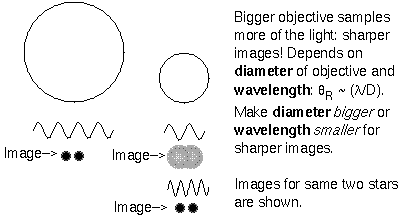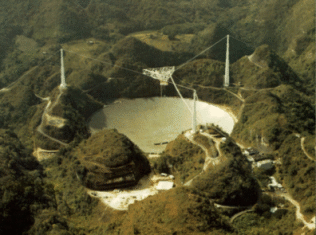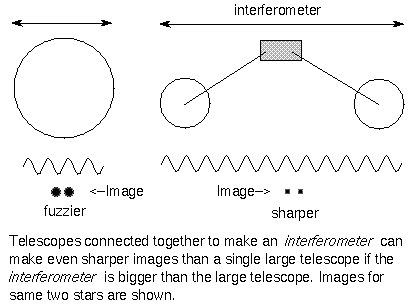Another important power of a telescope is its ability to make us see really small details and see sharp images. This is its
resolving power. Objects that are so close together in the sky that they blur together into a single blob are easily seen as separate objects with a good telescope. The resolving power is measured in the absolute smallest angle that can be resolved. The absolute minimum resolvable angle (smallest visible detail) in arc seconds

= 252,000 × (observation wavelength) / (objective diameter). The wavelength and diameter must be measured in the same length units (i.e., both wavelength and objective diameter given in meters or both in nanometers). A telescope with one arc second resolution would be able to see a dime from about 3.7 kilometers (2.3 miles) away. Modern telescopes are able to count the number of lines in President Roosevelt's hair on a dime at that distance.

The desire is to make

as small as possible. This can be done by making the observation wavelength small (e.g., use UV instead of visible light) or by making the objective diameter large. Another way to understand it is the more waves that can be packed on the objective, the more information the telescope detects and, therefore, the more detailed the image is. A 40-centimeter telescope has
two times the resolution of a 20-centimeter telescope at the same observing wavelength (

for the 40-centimeter telescope is one-half the

for the 20-centimeter telescope). However,
fluctuations in the atmosphere will usually smear images into a fuzzy blob about one arc second or more across so the resolution is usually limited to the resolution from a 12.5-centimeter telescope on the ground. I will discuss the atmosphere's effect on images further in the
another section and ways you can compensate for it.
 | The desire for greater resolving power is the main reason why radio telescopes are so enormous compared to their optical counterparts. Radio wavelengths are LARGE so the radio telescope must be LARGE to get decent resolving power (and also to increase the signal strength of the low-energy radio waves---light-gathering power!). The Keck 10-meter telescope is considered a very large optical telescope. However, it is easily dwarfed by the HUGE 305-meter Arecibo Radio Telescope at the Arecibo Observatory. A picture of this telescope is shown at left. This telescope was built in a natural bowl-shaped valley in Puerto Rico. Clicking on the image will show the telescope from other perspectives. |

 = 252,000 × (observation wavelength) / (objective diameter). The wavelength and diameter must be measured in the same length units (i.e., both wavelength and objective diameter given in meters or both in nanometers). A telescope with one arc second resolution would be able to see a dime from about 3.7 kilometers (2.3 miles) away. Modern telescopes are able to count the number of lines in President Roosevelt's hair on a dime at that distance.
= 252,000 × (observation wavelength) / (objective diameter). The wavelength and diameter must be measured in the same length units (i.e., both wavelength and objective diameter given in meters or both in nanometers). A telescope with one arc second resolution would be able to see a dime from about 3.7 kilometers (2.3 miles) away. Modern telescopes are able to count the number of lines in President Roosevelt's hair on a dime at that distance.
 as small as possible. This can be done by making the observation wavelength small (e.g., use UV instead of visible light) or by making the objective diameter large. Another way to understand it is the more waves that can be packed on the objective, the more information the telescope detects and, therefore, the more detailed the image is. A 40-centimeter telescope has two times the resolution of a 20-centimeter telescope at the same observing wavelength (
as small as possible. This can be done by making the observation wavelength small (e.g., use UV instead of visible light) or by making the objective diameter large. Another way to understand it is the more waves that can be packed on the objective, the more information the telescope detects and, therefore, the more detailed the image is. A 40-centimeter telescope has two times the resolution of a 20-centimeter telescope at the same observing wavelength ( for the 40-centimeter telescope is one-half the
for the 40-centimeter telescope is one-half the  for the 20-centimeter telescope). However, fluctuations in the atmosphere will usually smear images into a fuzzy blob about one arc second or more across so the resolution is usually limited to the resolution from a 12.5-centimeter telescope on the ground. I will discuss the atmosphere's effect on images further in the another section and ways you can compensate for it.
for the 20-centimeter telescope). However, fluctuations in the atmosphere will usually smear images into a fuzzy blob about one arc second or more across so the resolution is usually limited to the resolution from a 12.5-centimeter telescope on the ground. I will discuss the atmosphere's effect on images further in the another section and ways you can compensate for it.




No comments:
Post a Comment